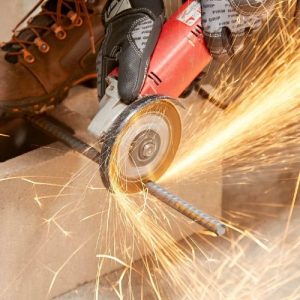 There’s nothing wrong with using a good, old-fashioned hacksaw, but there are faster, easier ways to cut metal. We’ll show you power tool tips and techniques for cutting the types and thicknesses of metal that DIYers handle the most.
There’s nothing wrong with using a good, old-fashioned hacksaw, but there are faster, easier ways to cut metal. We’ll show you power tool tips and techniques for cutting the types and thicknesses of metal that DIYers handle the most.
And whether you’d like to build custom cars or just fix a cracked lawn mower deck, learning to weld gives your DIY game a serious boost.
Ditch the Abrasive Grinder Discs
An angle grinder fitted with an abrasive metal-cutting disc works well to cut all kinds of metal, including bolts, angle iron, rebar, and even sheet metal. But the discs wear down quickly, cut slowly, and shrink in diameter as you use them. Instead, we recommend using a diamond blade that’s rated to cut ferrous metal. These will last much longer, cut faster and cleaner, and wear down much slower than abrasive discs.
Cut Metal with Your Circular Saw
It may not be an obvious choice, but fitted with the right blade, a circular saw is a great metal-cutting tool. In our test, it cut through rebar like a hot knife through butter. You can cut mild steel up to about 3/8 in. thick using a ferrous-metal-cutting blade. Be careful, though! Hot metal chips will fly everywhere. Put on your safety gear, keep bystanders away, and cover anything you don’t want to be coated with metal chips. There are two types: inexpensive steel-tooth blades and carbide-tooth blades. Carbide-tooth blades are more expensive but will last longer.
Cut Aluminum with Your Miter Saw
Making accurate cuts on aluminum rods, tubes and angles is easy with a miter saw and a blade designed to cut nonferrous metal (check the label). If the motor housing on your saw is open and could collect metal chips, tape a piece of cloth over the openings to protect the motor windings and bearings while you cut the aluminum. (Remember to remove it when the saw goes back into regular service or the motor will overheat.) Trapping the aluminum with a wood backer as shown reduces the danger of flying metal shards and makes it easier to hold the metal in place for cutting. This tip is especially important when you‘re cutting thin-walled pieces. Without the backing board, the blade will often catch on the metal and distort it and make it unusable.
Match the Blade to the Metal
With the right blade or grinding disc, you can cut almost any kind of metal. The key is to match the blade to the material. There are two types of metal: ferrous and nonferrous. (The term “ferrous” is derived from the Latin word “Ferrum,” which means iron.) Any metal that contains iron is a ferrous metal and requires a ferrous-metal cutting blade. Steel angle iron, steel roofing, rebar, and steel bolts are examples of ferrous-metal building materials. Most metal-cutting blades and discs are labeled for cutting either nonferrous or ferrous metal.
Use a Reciprocating Saw
The next time you reach for your hacksaw, grab your reciprocating saw instead. Mount a metal-cutting blade in your reciprocating saw and you’ve got the ultimate power hacksaw for cutting bolts, rods, pipes, and angle iron. A recip saw with a metal cutting blade also works great for remodeling demolition when there are nails and pipes to cut off. Here are a few tips for cutting metal with a recip saw:
• Set your saw to straight rather than oscillating if there’s a choice.
• Extend blade life by keeping the saw’s speed slow.
• Choose a blade with 20 to 24 TPI (teeth per inch) for thin metal, 10 to 18 TPI for medium-thickness metal, and about 8 TPI for thick metal.
• Buy bimetal or carbide-tooth blades for longer blade life.


